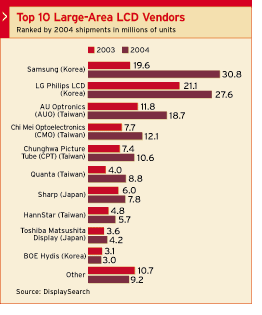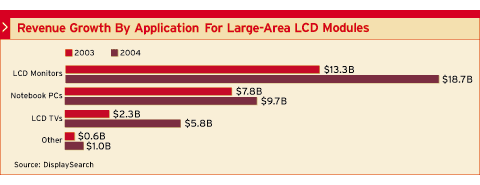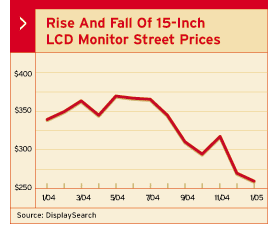China Syndrome
What's fanning the fever? Advancing LCD technology, declining prices and new applications are certain to keep unit sales of LCD panels growing at a rapid pace over the next decade, and everyone wants a piece of the market.
The channel has been reaping the benefits of falling prices and rising sales. But just how ongoing changes in the flat-panel manufacturing sector are going to impact U.S. resellers is anyone's guess. With so many factors in play, forecasting is difficult at best.
The production of large-area TFT LCDs, used mainly in notebook PCs, LCD monitors and LCD TVs, reached $35.2 billion last year, up 47 percent over 2003, according to research firm DisplaySearch. Meanwhile, prices rose in the first half of 2004, giving the LCD industry an estimated collective profit of $7 billion over that period. But then came the crash.
An oversupply in the second half caused prices to plummet, and factory utilization dropped to 86 percent from 93 percent, said Ross Young, president and CEO of DisplaySearch. The firm estimates that the industry wound up the year with earnings of $8 billion, most of it coming in the first half.
The industry has gone through boom-and-bust cycles before. But unlike previous downturns, the manufacturers this time did not significantly cut back on capital spending. "In fact, we'll see record capacity growth this year and almost as strong growth next year," Young said.

Young expects sales volume to increase and prices to stay flat or fall for some time. He estimated that vendors this year will ship about 181.3 million large-area LCD modules worldwide, up 31 percent compared with the 138.5 million units shipped last year.
As a result, according to DisplaySearch, first-tier manufacturers will continue to lose money on their sales of 17-inch and 19-inch LCD modules through the middle of next year, with profits eluding them on 15-inch modules until early 2007. Second-tier vendors will not make any profit at all on LCD modules at least through most of 2008, the research firm said.
Distributors anticipate continued downward pressure on prices, which should further stimulate sales, and a shift toward larger screens. "We hope to see adoption of 17-inch LCDs over 15-inch and then 19-inch over 17-inch," said Dan Schwab, vice president of marketing at D&H Distributing, Harrisburg, Pa.
LCD prices are by no means in a free fall, however. Several industry observers expect a temporary uptick in prices after LG Philips, Seoul, Korea, the second largest LCD maker after Samsung, said in mid-March that it planned to raise prices on 17-inch displays.
In response, Computer Technology Link, a Portland, Ore.-based system builder, decided to increase orders in March in anticipation of an April price increase. "When we get indicators like that, they usually ring true," said Stephen Moll, director of operations. "But prices eventually continue to fall."
Moll said he has identified a pattern to LCD monitor prices. "Normally, the vendors let prices slide awhile," he said. "Then they realize what is happening, and think, 'Whoa, we made a big mistake.' "
Even as investment in capacity is rising, Asia's LCD industry is consolidating. Last October, Seiko Epson and Sanyo Electric merged their LCD businesses and formed Sanyo Epson Imaging Devices, Tokyo. In January, Sony, also based in Tokyo, unveiled plans to acquire International Display Technology, a Japanese subsidiary of Chi Mei Optoelectronics, a Taiwanese LCD vendor. And in February, Sharp and Fujitsu, again Tokyo-based companies, unveiled an agreement to transfer Fujitsu Display Technologies' LCD research and development, manufacturing and sales operations to Sharp.
Moll said that consolidation can be good and bad. "It's bad because there's less price competition," he said. "It's good because you sometimes get rid of crummy manufacturers."
Another key factor impacting the price and technology of LCD monitors is the booming LCD television market. Whereas DisplaySearch expects the number of LCD modules produced for all uses to grow an average of 21 percent annually through 2008, it projects that production of television LCD panels will grow 52 percent annually over the same period.

As interest in flat-panel TVs picks up, production capacity could shift away from flat-panel monitors, putting a crimp on supply and buoying prices.
With some expecting the price of 32-inch and 37-inch flat-panel televisions to fall below $2,000 late in the third quarter, the IT industry could start feeling the impact of rising interest in flat-panel TVs this year, said Al Giazzon, former vice president of marketing at Irvine, Calif.-based BenQ America, the second largest maker of LCD monitors.
The competition to bring out lower-cost LCD televisions is fueling investment in sixth-generation and seventh-generation fabs. Sixth-generation technology enables the production of LCD motherglass with a size of 1,500mm x 1,850mm, or about double the size of the motherglass produced in fifth-generation fabs. Seventh-generation technology enables 1,870mm x 2,200mm LCD motherglass, nearly three times that of fifth-generation motherglass.
By producing larger sheets of motherglass, LCD manufacturers are able to increase their efficiency, cut manufacturing costs and produce larger-size modules.

Samsung, Seoul, has already started production in its first seventh-generation fab and plans to open a second such facility early next year. The new plants will largely be used to produce panels for LCD TVs, said Rey Roque, vice president of marketing for Samsung's Information Technology Division.
But the plants could also be used to more efficiently produce LCD monitors, which are currently being manufactured in fifth-generation plants. As a result, it is difficult to assess what impact the new production capacity will have on the display market. If flat-panel TVs absorb most of the capacity, at least in the near term, then the price of LCD displays could get squeezed. If the plants do begin churning out LCD displays, prices could fall.
Another key variable in the LCD industry is the impact of China on both production and sales.
Much of the new investment in LCD manufacturing is being done in mainland China in order to bring module production close to the Chinese-based manufacturers of notebook PCs, monitors and televisions. This results in a cut in labor costs and a shortening of the supply chain, said Jason Turk, product manager for LCD products at Acer America, San Jose, Calif. "Manufacturers are happy when panels come from a plant just five miles away," he said.
That could help lower prices. On the other hand, China's domestic market is also growing. This year, the greater China market, including Hong Kong and Taiwan, will account for 8.6 percent of worldwide sales of LCD monitors, according to DisplaySearch. By 2009, the greater China market could absorb--for domestic use--18.7 percent of the LCD monitors. In comparison, the research firm forecasts that the U.S. market's share of global sales will shrink to 29.5 percent from 32.4 percent.

Sally Wang, director of product marketing for business products at ViewSonic, Walnut, Calif., said one reason production is moving to China is to take advantage of the burgeoning market there. While the first quarter is typically slow in China because of the New Year celebrations, freeing up supply for the United States and other markets, sales should pick up later in the year, Wang said.
She believes the increasingly global market will absorb the new capacity coming online and that supply and demand will tend to move at the same pace, which would stabilize prices and the industry.
With all the variables in motion, though, it is difficult to determine whether supply will continue to outstrip demand or vice versa over the next months and years. But solution providers can anticipate some consolidation around larger manufacturers, which have the wherewithal to make big-dollar investments, as well as continued improvement in price/performance as those investments spur advancements in flat-panel technology.